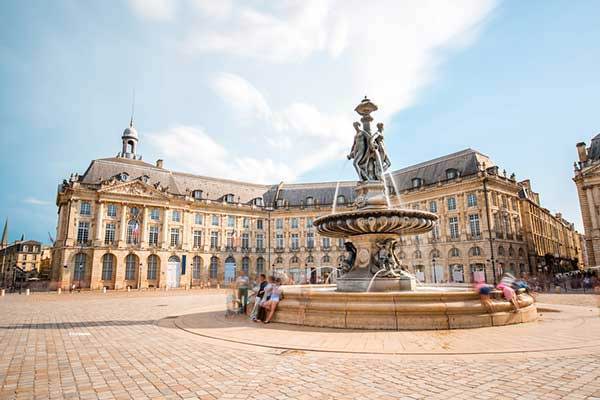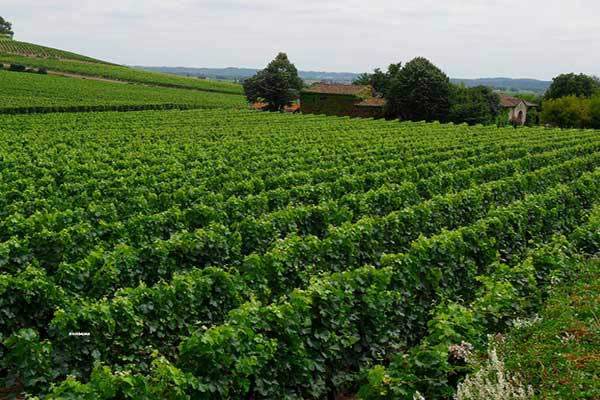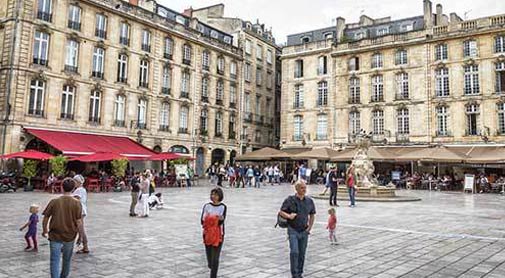Guide to Bordeaux, France - Cost of Living, Things to Do and Much More
Moving to a new place, especially to a completely new country, can be challenging. But, if your new residence is in Bordeaux, consider yourself lucky, since this French town is well known for its high standard of living, beautiful surroundings, and friendly citizens.
Located just a few miles from the Atlantic Ocean, in a picturesque part of France, Bordeaux is blessed with the Atlantic climate of warm summers and mild winters. Although it has its share of rainy days, most expats will say that the weather here is just perfect for relaxing and enjoying your free time.
Table of Contents
Retire in Bordeaux
Lifestyle in Bordeaux
Cost of Living in Bordeaux
Things To Do in Bordeaux
Bordeaux: A Snapshot
A Side Trip to Enchanting Saint-Émilion
The Takeaway on Bordeaux
Retire in Bordeaux

Strolling through the ancient streets, alongside the Garonne River, and knowing some of the world’s best known and loved vineyards are only a few minutes away helps you understand why Bordeaux is one of the most popular destinations for expats and tourists.
Bordeaux was ruled by the English in the 12th century, for two hundred years before returning to French rule. And, there are reminders of this English influence at every turn, from the magnificent 12th century Cathedral of Saint Andrew with the nearby bell-tower to The Tour Pey Berland, with its 282-step climb rewarding you with one of the best views of the city.
[question_evergreen]
You will also enjoy the outdoors, with hot sunny summers with temperatures in the mid to high 60 F and mild winters, but January can be particularly cooler with temperatures of around 59 F. The summer is a perfect time to take advantage of the hundreds of wineries within an hour’s drive, or the beautiful sandy beaches on the Atlantic coast only a 40-minute drive away.
In fact, transport connections to and from Bordeaux are very accessible. While there is an airport, the best way of travelling is on the TGV (very fast train) which glides through the countryside at 186 miles an hour, taking you less than three hours to Paris and only six hours from the center of London. And the French rail system SNCF also gives discounts for those over 60.
Bordeaux, like all of France, has an excellent health system with easy access to doctors and dentists. In fact, The World Health Organization (WHO) consistently rates France as having the best health system in the world. However, if you are not in the French system it is advisable to have health insurance as an expat.
Bordeaux is such a popular city some estimates say up to 20,000 people are moving there each year. It is well worth considering for an enjoyable and active retirement.
The economy of Bordeaux is built on wine and aeronautics, and, more recently, technology and telecommunications. If you’re moving to Bordeaux to pursue your career, there is a good chance you will work in one of these fields. To emphasize how important the wine industry is for this region, consider that there are more than 7,000 wineries and vineyards here, all of them producing approximately 960 million bottles of wine per year. The town itself is also the home of Europe’s major wine festival, Vinexpo.
Being so close to the Atlantic and residing on the Garonne river has made Bordeaux one of the best-developed harbors in this part of Europe, so it isn’t surprising that the trade market here is strong as well. Furthermore, 9 million tons of goods are transported to and from the city every year. As a university town, Bordeaux has a lot to offer and residents are accustomed to greeting foreigners into their hometown, and their workforce.
Lifestyle in Bordeaux

In Bordeaux, everyday life goes hand in hand with grand cultural monuments. More than 350 buildings, most of which date back to the 18th century are protected as UNESCO World Heritage Sites. There are at least 10 public parks, a public waterfront, and numerous green spaces. Museums are plentiful, as are galleries and concert halls. Yet, one of the more recent tourist attractions is the Miroir d’Eau (or simply Water Mirror) a reflecting pool, which is particularly popular during summer.
A significant contingent of foreign students and expats has built a strong multinational community here. As a university town, Bordeaux is quite lively, with a highly attractive nightlife and cultural scene. The liveliest areas can be found around the city center and the riverbank.
Needless to say, tourism plays a significant role in the city’s economy and lifestyle. Luckily, as the ninth biggest town in France, the streets of Bordeaux never seem overcrowded. The town is also well connected to other cities in France, as well as other major European destinations. International flights come through Bordeaux–Mérignac Airport, and the main train station, Gare Saint-Jean, is close to the city center. Throughout the town, citizens commute by tramway or electric bus. There is also a ferry that connects the eastern and western parts of the town. Yet, above all else, the most popular vehicle in the town is a bicycle. Bordeaux is almost completely flat and accessible by bike and many people utilize the public bike-sharing network VCUB.
One of the greatest things about living in France is the fact that healthcare, social care, and primary education is government funded, and is free for all. Bordeaux International School is popular among expats as classes are held both in English and in French.
The University of Bordeaux has a reputation for high standards and is composed of several different institutions. The most notable are the College of Science and Technology and the Institute of Vine and Wine Science, both offering prolific exchange programs.
Cost of Living in Bordeaux

As it is one of the most popular tourist destinations in Europe with its ready access to wineries, beaches, and world class restaurants, Bordeaux has a higher cost of living than much of France.
While you’ll find supermarket prices, utilities and communications are similar to the rest of the country accommodation is more expensive in Bordeaux.
A baguette from the artisan boulanger (baker) will set you back $1.30, or you can get one from the supermarket for as little as 50 cents, and an excellent bottle of Bordeaux wine for $7.
The cost of restaurant meals varies dramatically but you can get an excellent three course meal with wine for two people for around $50.
A two-bedroom apartment costs around $800 to $1,000 a month.
Below is a monthly budget for a couple living in Bordeaux:
| Expense | $U.S. |
| Rent | 800 |
| Utilities (Electricity, Gas, Water, Heating) | 100 |
| Groceries (incl. Wine) | 540 |
| Cell Phones (x2 – not including handset) | 30 |
| Internet | 32 |
| Dining Out | 200 |
| Local Public Transport Monthly Pass | 30 |
| Total: | $1,732 |
Things To Do in Bordeaux: Where Fine Wine, Elegance, and Innovative Art Meet
By Tricia Mitchell

It was early evening in Bordeaux, and the day’s waning sunlight illuminated the arches of the graceful brick bridge, the Pont de Pierre. Nearby, in the Miroir d’Eau, the world’s largest reflecting pool, people of all ages frolic on the wet, mirror-like pavement. As they glide through the fountain’s mist, seemingly walking on water, they grin enthusiastically. I found this joie de vivre to be contagious and couldn’t stop smiling along with them.
In the background, the grand 18th-century buildings overlooking Bordeaux’s most famous square were briefly overshadowed as an ultra-modern tram whizzed by. This pre-sunset scene seemed to perfectly encapsulate what makes Bordeaux so special: traditional, yet innovative, while simultaneously elegant and free-spirited.
[france_signup]
It was our second visit to Bordeaux. So enthralled were my husband and I with our first trip there that we’d decided to return. During our eight-day stay, we checked out several museums and art venues, tasted the region’s world-famous wine, meandered along the Garonne River on a boat cruise, and strolled Bordeaux’s cobbled streets while admiring its incredible architecture.

From Roman Rule to One of the World’s Busiest Ports
Nicknamed the “Port of the Moon” (due to the river’s crescent-shaped bend), Bordeaux is believed to have originally been settled by the Celts, who called it Burdigala. The Romans later conquered the area, introducing vines. They also left behind an amphitheater, part of which you can still see today.
After subsequent centuries of invasions by numerous peoples (including the Vandals and the Franks), Bordeaux came under English rule for three centuries. Thanks to its strategic location, Bordeaux eventually developed into one of the busiest port cities in the world. Many of the city’s most recognizable landmarks—including the Place de la Bourse (Stock Exchange Square) and the Grand Théâtre (opera house) were constructed during the 18th century. In the 20th century, Bordeaux had pockets of economic depression, leading it to be nicknamed, “Sleeping Beauty.” After decades of rejuvenation projects, the city emerged as one of France’s most dynamic and beautiful cities.
In 2007, UNESCO added Bordeaux to its World Heritage List, noting that the city’s number of protected buildings is exceeded only by Paris. Today, Bordeaux’s city proper is home to 260,000 people, with the metropolitan population at about 1.3 million.
Savoring—and Learning—About Wine
Acclaimed globally for its wine, the Bordeaux area boasts roughly 60 appellations and more than 7,000 winemakers. The prestigious wine estates outside of Bordeaux are attractions in their own right, but wine connoisseurs can also find delightful wine bars, shops, and museums within Bordeaux itself.
The Cité du Vin is Bordeaux’s latest wine-tourism attraction. This futuristic complex is shaped like a shimmering decanter and features a museum, cultural center, restaurants, and shops. The displays here are largely hands-on and cover the history of winemaking, production methods in Bordeaux and around the world, and much more. One of the more popular displays features glass-encased objects that you can sniff such as coffee beans, and lemons, illustrating the varied aromas to pay attention to when sampling wine. After you’ve explored the exhibits, head to the 8th-floor belvedere for superb views of Bordeaux and a complimentary glass of wine The tickets cost €21 in 2022, but the price has been raised to €27 for adults in 2023.

For a much more intimate experience, also visit the Musée du Vin et du Négoce (Wine & Trade Museum). This museum is housed in an atmospheric 18th-century building that was once owned by an Irish wine merchant. Exhibits are set up underneath the vaulted ceilings, and thanks to the stone cellar’s musty aroma, it’s easy to imagine this space in action centuries ago. At the end of our visit, one of the guides gave us a brief overview of Bordeaux’s diverse wine-growing areas. We were also treated to two samples of wine, as well as raisins soaked in Sémillon and coated with dark chocolate.
Art: From the Traditional to the Cutting-Edge
During World War II, Bordeaux was occupied by Germany, and a gargantuan submarine base was constructed there. From 1940 to 1943, this concrete structure was able to house more than a dozen submarines. However, after the defeat of the Axis powers, this monstrosity proved difficult to dismantle. Eventually, it was transformed into a unique cultural center that hosts special events.
One of the most popular exhibitions inside this space today is Les Bassins des Lumières (Pools of Light)—said to be the largest digital art center in the world. When you visit, scenes from vibrant paintings are projected on the walls of the submarine’s water-filled pens. It’s all brilliantly choreographed to emotive music. The exhibition changes every year. When we went, Venetian vistas were married with Italian operas. The effect was incredibly beautiful. I suppose it was all the more moving given that this space—created for acts of death and destruction—is now used to facilitate beautiful and creative works.
For a more traditional—but equally worthwhile art appreciation experience—head to Bordeaux’s Musée des Beaux-Arts. Established more than 200 years ago, this fine arts museum is home to paintings by Renoir, Picasso, and Flemish and Dutch artists. I especially enjoyed the paintings depicting Bordeaux street scenes throughout the centuries.
Bordeaux: A Snapshot
Bordeaux is located in France’s Nouvelle-Aquitaine region, 365 miles southwest of Paris. Bordeaux’s airport mainly services flights to European airports; some routes are seasonal. In addition, Bordeaux is well-connected to Paris via a TGV (high-speed) train line that only takes two hours.
Getting around: Given its great number of pedestrianized areas, Bordeaux is quite walkable, but there’s also an excellent bus and tram network connecting Bordeaux’s urban core.
The Bordeaux CityPass is available for visits of one, two, or three days. It offers free transport, and free or reduced entrance to Bordeaux’s most well-known attractions, including the Cité du Vin, the Bassins des Lumières, and more than a dozen museums and monuments. Passes start at €31 ($33).
What to eat and drink: From French cuisine to Moroccan and Thai fare, Bordeaux has an impressive range of restaurants. At Café Piha, we enjoyed a delightful brunch of stellar coffee and Eggs Benedict with freshly toasted bread and slices of avocado. Books & Coffee, a charming café, was our favorite spot for café viennois (coffee topped with a colossal dollop of cream) and a brilliant tart studded with pistachio ganache and plump raspberries. When in Bordeaux, you also must try the celebrated canelé, a rum-and-vanilla-flavored pastry.
Where to stay: From elegant hotels to self-catering apartments, Bordeaux has a great variety of accommodation options. L’Invitation au Voyage is a B&B housed in an 18th-century stone building, with an interior courtyard featuring an ornamental iron staircase. The property is just footsteps away from a tram stop, as well as the city’s Museum of Aquitaine, which houses prehistoric, Roman, and Enlightenment-era treasures.
For something more luxurious, L’Hôtel Particulier, a boutique hotel, offers guest rooms, studio apartments, and more. Located near Bordeaux’s most famous cathedral, some rooms feature ornate marble fireplaces or balconies.
A Side Trip to Enchanting Saint-Émilion
Just 30 miles from Bordeaux, Saint-Émilion makes for a splendid day trip or overnight jaunt. Known for its celebrated wine and charming ambiance, St-Émilion is among France’s oldest winemaking regions. Since 1999, both the village of St-Émilion and the surrounding vineyards have been included on UNESCO’s World Heritage List. Despite only having about 2,000 residents, the community has a variety of delightful restaurants and lovely accommodation options.
Getting there: From Bordeaux, you can reach St-Émilion by train, car, or organized tour in about 40 minutes. Train tickets cost roughly €10 ($10.90) each way. Note that the train station is located one mile from the center of town.
Where to stay: We spent two nights at Au Logis des Remparts, a boutique hotel located right in the center-ville. We especially enjoyed our dips in the hotel’s outdoor swimming pool, as well as the delightful breakfasts served in the tranquil courtyard.
Where to taste wine: Saint-Émilion is home to elegant wineries, as well as inviting shops where you can taste wine. One of the more unusual wine-tasting spots is Les Cordeliers, a 14th-century convent with ruined cloisters. Sparkling wine has been produced here since 1892. You can visit this winery’s cellars, as well as its underground tunnels, which run for nearly two miles. You can also customize a picnic basket and enjoy it on the grounds of this historic property. Baskets are studded with gourmet treats such as foie gras, tapenades, cheese, or St-Émilion’s traditional macarons.
You’ll also find esteemed Bordeaux wine on the menus of St-Émilion restaurants, and you might even brush shoulders with winemakers. While eating dinner one night, we just happened to be seated next to a jovial winemaker who kindly passed us a bottle of wine he produced, eager for us to try a glass.
Highlights: For exceptional bird’s-eye views of Saint-Émilion’s golden-limestone buildings, and the vineyards that encircle the town, climb the 196 steps to the top of the Monolithic Church Bell Tower (Clocher de l’Église Monolithe). The base of this unique church was hewn out of the living rock in the 12th century. Several hilly streets—called tertres—connect the upper and lower parts of Saint-Émilion. The tertres are made from irregular stones that once served as ballast for English merchant ships coming to the area to collect barrels of wine. The merchants then left these stones behind after they loaded up the boats with wine.
The Takeaway on Bordeaux
Regardless of your age, family situation, budget, or profession, Bordeaux is a welcoming city that provides many opportunities and cultural delights that will make you feel right at home in no time.

